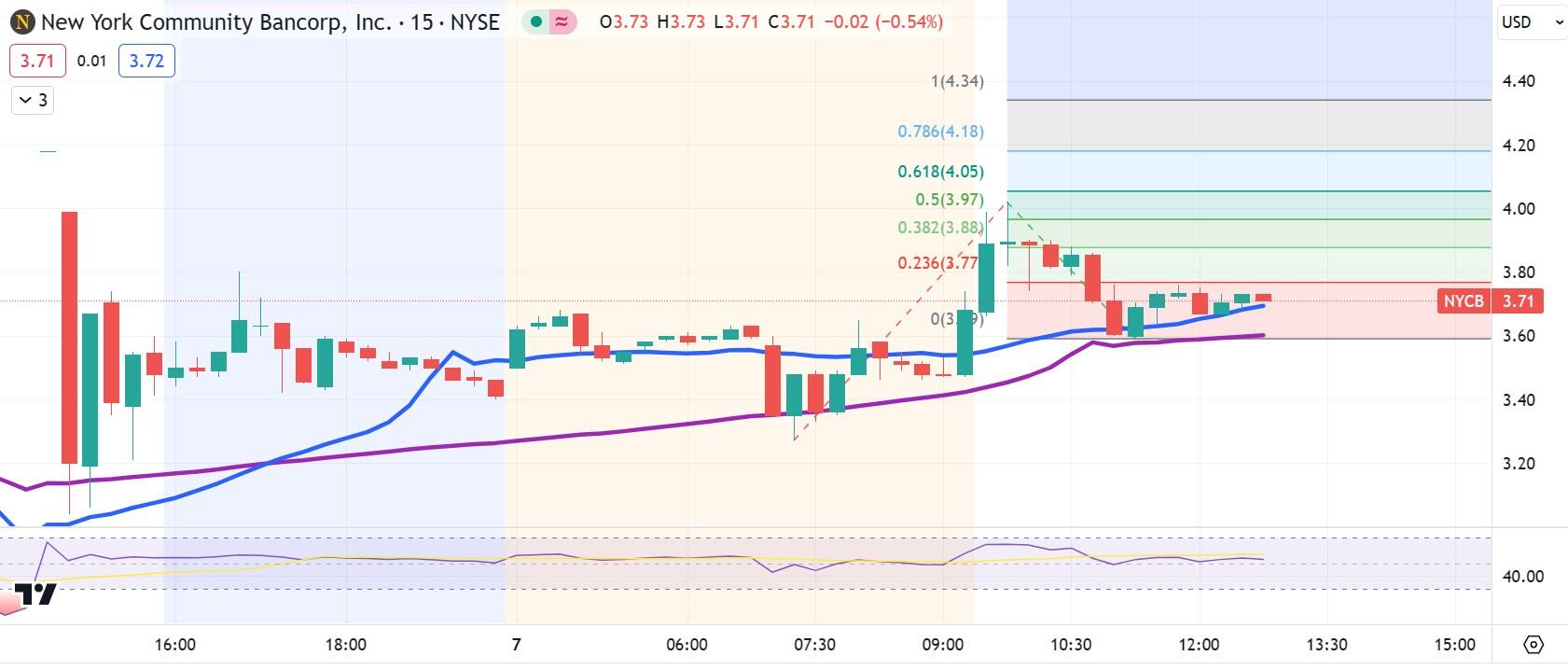NYCB stock makes gains on Thursday following Mnuchin rescue.
New York Community Bancorp says deposits fell by 7% over past month.
NYCB cuts dividend to $0.01 per quarter.
Liberty Strategic Capital and other institutions invested $1 billion to shore up bank on Wednesday.
New York Community Bancorp (NYCB) shot up 12% at the start of trading on Thursday, but that lead was cut to 4.5% by the afternoon after the embattled lender announced that 7% of deposits had left the bank over the past month.
It would seem Wall Street is warming overall to the $1 billion lifeline handed to the bank on Wednesday from a consortium led by the likes of former Treasury Secretary Steve Mnuchin. But traders are uncertain whether the danger has ended after the bank received a flurry of downgrades earlier this week.
Both Moody’s and Fitch downgraded the bank on Monday after its CEO left recently due to what the board deemed “material weaknesses” to its lending oversight.
New York Community Bancorp stock news
The fact that 7% of deposits have fled New York Community over the past month is rebuffed somewhat by an earlier announcement that deposits had risen from $81.4 billion to $83 billion between the end of 2023 and February 4, 2024.
Additionally, NYCB stock continues gaining despite the news on Thursday, because the bank has very little exposure to account holders with more than $250,000 in deposits compared with its peers. $250,000 is the amount that is insured by the Federal Deposit Insurance Corporation (FDIC), so it is unlikely that New York Community would suffer the same fate as First Republic or Silicon Valley Bank during the 2023 regional banking crisis when fleeing depositors led to those institutions’ collapse.
Alongside the announcement of declining deposits on Thursday, the board announced it would once again cut its quarterly dividend — this time to one cent. The dividend had already been cut at the start of the year from $0.17 to $0.05 in order to shore up a balance sheet injured by a faltering commercial real estate (CRE) portfolio and a higher regulatory burden.
In a fascinating twist, New York Community’s heightened regulatory burden stems from last year’s regional banking crisis when it purchased loans and deposits from the failed Signature Bank. This acquisition pushed its assets above $100 billion, which subjects the bank to more stringent protocols regarding its coverage ratio.
Steve Mnuchin and company appear to have worked out a sweetheart deal. When the bank announced that it was seeking outside investment to protect itself on Wednesday, the stock fell nearly 50% before the New York Stock Exchange halted trading. The stock then reopened to trading at a much higher level once the investment was announced from Mnuchin and other partners.
NYCB stock traded as low as $1.70 on Wednesday before the trading halt. Shares reopened above $4 per share once it was announced that Mnuchin’s Liberty Strategic Capital would invest $450 million, Hudson Bay Capital Management would invest $250 million and Reverence Capital Partners would invest $200 million. Other entities and individuals, including Citadel Global Equities, would round out the deal to provide the bank with a $1.05 billion cash infusion.
For their investment, members got a great deal, based on the current share price on Thursday. The investor group got to purchase new shares of common stock at $2 per share, plus preferred convertible stock at $2 per share. Additionally, they received the option to buy warrants with a conversion price of $2.50.
If Mnuchin and the rest can turn New York Community around, then they are all looking at a quite valuable payday. The agreement is scheduled to be finalized on March 11. Top executives have already left the company, and the new investor team will be filling out much of a new nine-member board.
S&P 500 FAQs
The S&P 500 is a widely followed stock price index which measures the performance of 500 publicly owned companies, and is seen as a broad measure of the US stock market. Each company’s influence on the computation of the index is weighted based on market capitalization. This is calculated by multiplying the number of publicly traded shares of the company by the share price. The S&P 500 index has achieved impressive returns – $1.00 invested in 1970 would have yielded a return of almost $192.00 in 2022. The average annual return since its inception in 1957 has been 11.9%.
Companies are selected by committee, unlike some other indexes where they are included based on set rules. Still, they must meet certain eligibility criteria, the most important of which is market capitalization, which must be greater than or equal to $12.7 billion. Other criteria include liquidity, domicile, public float, sector, financial viability, length of time publicly traded, and representation of the industries in the economy of the United States. The nine largest companies in the index account for 27.8% of the market capitalization of the index.
There are a number of ways to trade the S&P 500. Most retail brokers and spread betting platforms allow traders to use Contracts for Difference (CFD) to place bets on the direction of the price. In addition, that can buy into Index, Mutual and Exchange Traded Funds (ETF) that track the price of the S&P 500. The most liquid of the ETFs is State Street Corporation’s SPY. The Chicago Mercantile Exchange (CME) offers futures contracts in the index and the Chicago Board of Options (CMOE) offers options as well as ETFs, inverse ETFs and leveraged ETFs.
Many different factors drive the S&P 500 but mainly it is the aggregate performance of the component companies revealed in their quarterly and annual company earnings reports. US and global macroeconomic data also contributes as it impacts on investor sentiment, which if positive drives gains. The level of interest rates, set by the Federal Reserve (Fed), also influences the S&P 500 as it affects the cost of credit, on which many corporations are heavily reliant. Therefore, inflation can be a major driver as well as other metrics which impact the Fed decisions.
New York Community stock forecast
With the dilution made to NYCB common stock, it is less useful to look at historical levels of support and resistance. The 15-minute chart below tells us how the stock is being viewed by Wall Street currently.
NYCB stock has spent the whole day in the green, but its early lead has been steadily dissipating. The Thursday open saw a huge jump to the $3.90s give way to the $3.60s, but buyers were present to pick up the slack at that level. NYCB stock entered the afternoon in the $3.70s before falling to a daily low at $3.56.
From here it looks like the 38.2% Fibo at $3.88 and the 61.8% Fibo at $4.05 are the levels that will deliver confidence. But any breakdown of $3.60 will be worrisome for bulls.

NYCB 15-minute chart
Information on these pages contains forward-looking statements that involve risks and uncertainties. Markets and instruments profiled on this page are for informational purposes only and should not in any way come across as a recommendation to buy or sell in these assets. You should do your own thorough research before making any investment decisions. FXStreet does not in any way guarantee that this information is free from mistakes, errors, or material misstatements. It also does not guarantee that this information is of a timely nature. Investing in Open Markets involves a great deal of risk, including the loss of all or a portion of your investment, as well as emotional distress. All risks, losses and costs associated with investing, including total loss of principal, are your responsibility. The views and opinions expressed in this article are those of the authors and do not necessarily reflect the official policy or position of FXStreet nor its advertisers. The author will not be held responsible for information that is found at the end of links posted on this page.
If not otherwise explicitly mentioned in the body of the article, at the time of writing, the author has no position in any stock mentioned in this article and no business relationship with any company mentioned. The author has not received compensation for writing this article, other than from FXStreet.
FXStreet and the author do not provide personalized recommendations. The author makes no representations as to the accuracy, completeness, or suitability of this information. FXStreet and the author will not be liable for any errors, omissions or any losses, injuries or damages arising from this information and its display or use. Errors and omissions excepted.
The author and FXStreet are not registered investment advisors and nothing in this article is intended to be investment advice.
>>> Read full article>>>
Copyright for syndicated content belongs to the linked Source : FXStreet – https://www.fxstreet.com/news/new-york-community-bancorp-stock-goes-on-wild-ride-after-receiving-lifeline-from-steve-mnuchin-202403071756































